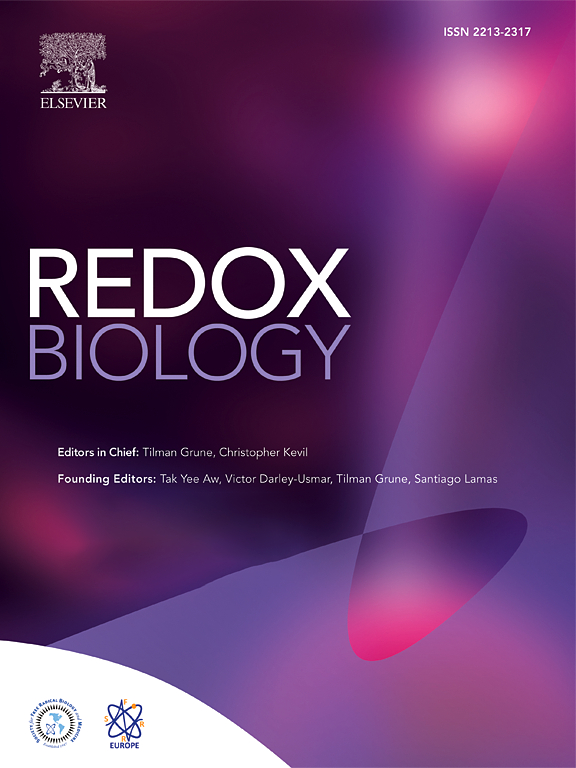治疗阿尔茨海默氏症的药物再利用方法大有可为:吉维诺司他能改善 APP/PS1 小鼠的认知行为和病理特征。
IF 11.9
1区 生物学
Q1 BIOCHEMISTRY & MOLECULAR BIOLOGY
引用次数: 0
摘要
阿尔茨海默病(AD)是最常见的神经退行性疾病,以记忆力减退、言语和运动缺陷、人格改变和心理障碍为特征。阿尔茨海默病的确切病因尚不清楚。目前的治疗方法主要是维持神经递质水平或针对β-淀粉样蛋白(Aβ),但这些方法只能缓解症状,不能逆转疾病。开发新药耗时长、成本高、失败率高。利用多组学技术重新定位药物已成为一种新策略。基于 LINCS-L1000 数据库中 40,000 多种药物在人体细胞中的转录组扰动数据,我们的研究采用 Jaccard 指数和超几何分布检验进行反转录特征匹配分析,确定 Givinostat 为治疗 AD 的潜在药物。我们的研究发现,吉维诺他能改善模型的认知行为和大脑病理学,并增强海马突触可塑性。转录组测序显示,吉维司他治疗后,APP/PS1小鼠大脑中线粒体呼吸链复合蛋白的表达量增加。在功能上,Givinostat能恢复Aβ诱导的HT22细胞的线粒体膜电位,减少活性氧,增加ATP含量。此外,它还能改善 APP/PS1 小鼠海马中线粒体的形态和数量,提高脑葡萄糖代谢活性。这些作用与 Givinostat 促进线粒体生物生成和改善线粒体功能有关。总之,Givinostat通过靶向线粒体功能障碍,为治疗AD提供了一种前景广阔的新策略。本文章由计算机程序翻译,如有差异,请以英文原文为准。
A promising drug repurposing approach for Alzheimer's treatment: Givinostat improves cognitive behavior and pathological features in APP/PS1 mice
Alzheimer's disease (AD) is the most common neurodegenerative disease, characterized by memory loss, speech and motor defects, personality changes, and psychological disorders. The exact cause of AD remains unclear. Current treatments focus on maintaining neurotransmitter levels or targeting β-amyloid (Aβ) protein, but these only alleviate symptoms and do not reverse the disease. Developing new drugs is time-consuming, costly, and has a high failure rate. Utilizing multi-omics for drug repositioning has emerged as a new strategy. Based on transcriptomic perturbation data of over 40,000 drugs in human cells from the LINCS-L1000 database, our study employed the Jaccard index and hypergeometric distribution test for reverse transcriptional feature matching analysis, identifying Givinostat as a potential treatment for AD. Our research found that Givinostat improved cognitive behavior and brain pathology in models and enhanced hippocampal synaptic plasticity. Transcriptome sequencing revealed increased expression of mitochondrial respiratory chain complex proteins in the brains of APP/PS1 mice after Givinostat treatment. Functionally, Givinostat restored mitochondrial membrane potential, reduced reactive oxygen species, and increased ATP content in Aβ-induced HT22 cells. Additionally, it improved mitochondrial morphology and quantity in the hippocampus of APP/PS1 mice and enhanced brain glucose metabolic activity. These effects are linked to Givinostat promoting mitochondrial biogenesis and improving mitochondrial function. In summary, Givinostat offers a promising new strategy for AD treatment by targeting mitochondrial dysfunction.
求助全文
通过发布文献求助,成功后即可免费获取论文全文。
去求助
来源期刊

Redox Biology
BIOCHEMISTRY & MOLECULAR BIOLOGY-
CiteScore
19.90
自引率
3.50%
发文量
318
审稿时长
25 days
期刊介绍:
Redox Biology is the official journal of the Society for Redox Biology and Medicine and the Society for Free Radical Research-Europe. It is also affiliated with the International Society for Free Radical Research (SFRRI). This journal serves as a platform for publishing pioneering research, innovative methods, and comprehensive review articles in the field of redox biology, encompassing both health and disease.
Redox Biology welcomes various forms of contributions, including research articles (short or full communications), methods, mini-reviews, and commentaries. Through its diverse range of published content, Redox Biology aims to foster advancements and insights in the understanding of redox biology and its implications.
 求助内容:
求助内容: 应助结果提醒方式:
应助结果提醒方式:


